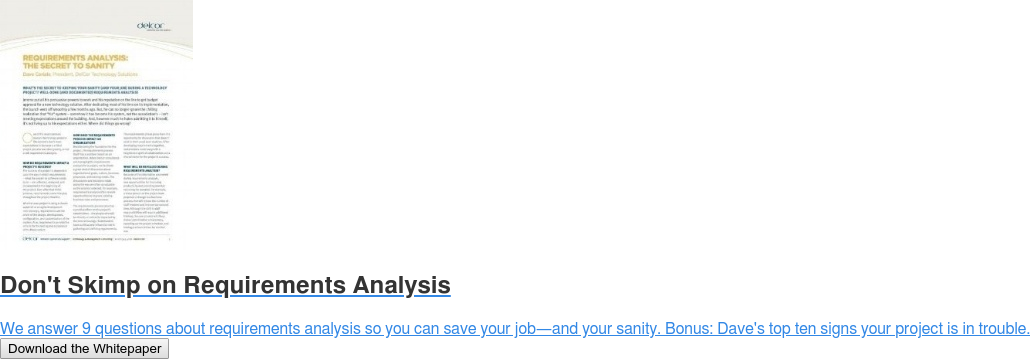Selecting and implementing a new association management system (AMS) or content management system (CMS) can be a daunting task. It’s one of the biggest technology investments your association will ever make. But no pressure! You’ve got questions and we’ve got answers.
We know a thing or two about AMS and CMS selection and implementation. In the last decade alone, we’ve been involved with more than 200 selection projects. And our first AMS selection project was way back in 1994, the year Friends and Forest Gump came into our lives. Yup, dating ourselves.
To answer some of your questions about project timelines, we tapped the insight and expertise of our resident DelCorians.
How long will my association’s system selection and/or implementation take?
Wendy Raulin, PMP
This answer usually surprises people: it can take 12-18 months from the start of the selection process to going live with a new solution, such as a content management system (CMS), association management system (AMS), or financial management system (FMS).
Allow 4-6 months to carry out the necessary due diligence for the selection:
- Identifying requirements
- Going through the Request for Proposal (RFP) process
- Viewing product demonstrations
- Checking references.
Then, the complexity of your requirements determines the length of time needed for implementation.
Dave and Loretta can break this timeline down further for CMS and AMS selection/implementation.
Dave Coriale
Usually, the selection of a content management system (CMS) takes 3-4 months, but the actual time depends on a few factors:
- Number of stakeholders involved
- Length of time it takes to make a decision
- Number of business processes affected by the software
Selecting a CMS usually takes less time than selecting an AMS because an AMS selection involves more people. Remember, we’re only talking about selection here, not implementation.
Loretta M. DeLuca, FASAE
My usual answer to this question is: typically 6 months for AMS selection plus about 12 months for its implementation. But, in reality, there’s a wide variance.
For most organizations, it’s difficult to make an AMS selection in less than 6 months. A full process of due diligence requires steps that take a good deal of time to complete. For example, you have to allow for the “dead period” of four weeks when vendors are generating their response to the RFP. Or, when scheduling 3 demos during a one-week period, you may need a longer lead time than anticipated due to the conflicts inherent in the calendars of multiple parties.
Always be conservative when creating a timeline for implementation. If your vendor proposes a 12 month go-live date, add at least 6 months to that timeline because it’s quite common for things to start going off the rails, on the vendor’s end and/or your end.
A few of the myriad of examples are:
- The organization’s testing team doesn’t get its work done in the specified amount of time, thereby stalling the vendor’s implementation process.
- The organization’s data isn’t ‘clean’ enough, so the vendor has to do another round of data conversion.
If the project ends up taking less time, your organization ‘wins.’ However, if the project takes longer than the original, non-modified estimate, your team (and leadership) could end up feeling frustrated and disappointed.
When coming up with a timeline, it’s crucial to keep your organization’s culture in mind. Is it typically slow in completing projects? Does it take a long time to make decisions? If so, the entire process of selection and implementation is likely to take longer than the norm.
How much staff time will we need for a selection/implementation project?
Gretchen Steenstra, PMP
The amount of staff effort needed will depend on the system, project complexity, and the depth of your team’s experience. Here’s a rough estimate of the staff hours needed to support a selection and implementation project:
- Design/requirements phase: 10-20 hours per week to gather and review system requirements.
- Weekly project meetings: Average of 1-2 hours per week throughout the project to refine requirements, discuss design options, prepare for testing, etc.
- Implementation: Average of 2 hours per day during the implementation phase—this will ebb and flow based on the vendor’s delivery process.
- Testing: 2-4 hours per testing session. Don’t forget to include time for retesting issues to make sure they’ve been resolved.
- Launch prep: 1-2 days.
- Post-launch: A minimum of 2-4 hours per day for the first 2-3 weeks to work out any final issues, and to help colleagues or customers adopt the new system.
Look ahead and identify any projects that can be deferred or skipped so your staff can make room in their schedules for this project. For example, if the membership team is considering a new member-get-a member campaign, they may wish to postpone the campaign until the new AMS is implemented. Or, an event management team should probably put off any decision to select a new abstract management system or change an existing process to manage speakers.
What else do associations need to know about an IT project timeline?
Tobin Conley, CAE
A project manager is necessary when you’re dealing with long timelines that are subject to change. This skillset is often overlooked by associations. You can’t rely on the vendor’s project manager; they’re herding their cats, not yours.
Your team’s project manager watches the project timeline and appropriately sets and manages expectations. They watch for, report upon, and address delays that might have a ripple effect on the timeline. Don’t make any promises to your board until you and your vendor have agreed to a timeline with built-in buffers for unforeseen delays, like staff turnover on either side’s team.
Requirements have a significant impact on your selection and implementation. Get your project off to a solid start with a thorough requirements analysis. Download our free white paper to learn more: Requirements Analysis: The Secret to Sanity.



